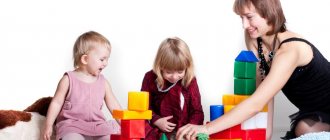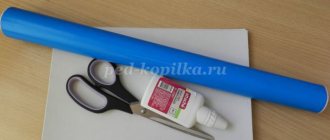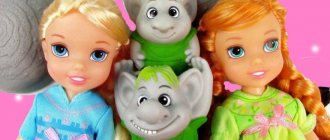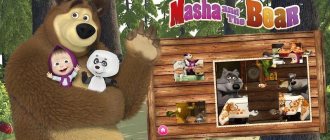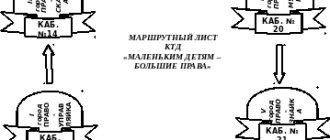DIY math games
Elena Margelova
DIY math games
Game “Collect a fly agaric”
Goal: to consolidate the ability to correlate quantity and number.
Materials : Separate fly agaric caps with different numbers of white dots within 10, and separately fly agaric legs with numbers from 1 to 10.
Description: You can play either individually or as a whole group, taking turns going out and looking for the right hat with the required number of white dots for the leg with the selected number. (children do not see what number the leg will come up with, they are turned upside down, and the child draws to choose from)
Game “Collect a Caterpillar”
Goal: to consolidate knowledge about numbers and their place in the series of natural numbers.
Materials : separate parts of the caterpillar with different numbers within 10.
Description: Each part of the caterpillar is scattered randomly, children collect it in order.
Game “PICK UP THE CLOTHESPICK”
Goal: consolidation of knowledge about the relationship between quantity and number within 10, repetition of the names of geometric shapes, development of fine motor skills.
Materials : drum with sectors in which different geometric shapes are located in different quantities within 10. Clothespins with numbers.
Description: Children are given clothespins with numbers and a tape measure with different numbers of geometric shapes. You can spin the roulette, determining the number of geometric shapes in the drawn sector, name them and find a clothespin with the required number, or you can simply turn the circle over and attach clothespins with the required numbers, while naming the geometric shapes.
Game "FISHING"
Goal: strengthening the skill of solving examples within 10, forming ideas about the composition of numbers within 10.
Materials : cardboard buckets, fish with examples within 10 of addition and subtraction.
Description: You can work individually with one child, he puts the fish in the right buckets, or you can work with a group of children, who will fill the buckets with fish faster and correctly.
Game "GUESS WHICH CHICKEN IS LOST?"
Goal: determine the place of the number in the natural series, name the missing number.
Materials : chicken figures with numbers from 1 to 10.
Description. The chickens are displayed in natural row sequence. Invites the children to look at how they stand, to see if any numbers are missing. After the children guess which chicken is missing, the hidden one is shown and put in its place.
You can use chickens in other tasks, for example: chickens are placed randomly, and children line them up in the correct sequence.
Game “GUESS WHICH IS THE COUNT...”
Goal: to consolidate the skill of ordinal counting.
Description. On a typesetting canvas or on a board, all the heroes of the fairy tale “Turnip”
.Task: “Now we will play the game
“Guess which hero I hid?”
Look how many heroes there are? After listening to the children’s answers, he explains the task: “Try to remember in what order the characters are located. Then I will hide the first hero, and you will tell me which one he was. Who wants to count the heroes in order? The child counts: The first is the grandfather, the second is the woman, etc. Then the children close their eyes, and the teacher removes one hero. The exercise is repeated several times.
Information portal for parents and educators
Do-it-yourself mathematical didactic game for the younger group.
Children's development largely occurs through play. Children 2-3 years old, who are just joining the ranks of preschoolers, begin to spend a lot of time in a group of peers, gaining new knowledge. Do-it-yourself didactic games are especially valuable in preschool educational institutions. This is the warmth and care of a master who puts his soul into each child, as well as the opportunity to give children sensory development and first skills in mathematics and logic. We present to your attention a master class on creating a bright didactic game with a mathematical bias for the younger group of preschool educational institutions, which older preschoolers will also enjoy playing. The process is accompanied by pictures, so it will be easier for you to create.
Volumetric compositions from simple figures
Younger children can be asked to make an applique using circles of colored paper. From them, if you have imagination, you can make both flat compositions on a white sheet and three-dimensional ones.
With circles, abstract thinking will develop well if you invite your child to complete a free drawing.
When children's imagination is already somewhat developed, they move on to more complex tasks. For example, mosaic applique is a good option for further development of skills.
Offer the student several figures of different or the same shape so that he can come up with a composition himself. If there are enough colors, you can get some pretty colorful images.
Preview:
MBU "Scientific Methodological Center"
city of Gubkin, Belgorod region
“Making manuals for the development of mathematical concepts in children with your own hands”
Methodological association of preparatory group teachers
Prepared by: MBDOU teachers
General developmental kindergarten
No. 34 “Toy” Lokteva P.A. Fominova E.S.
For the mental development of children, their acquisition of mathematical concepts, which actively influence the formation of mental actions that are so necessary for understanding the world around them, is essential.
Many prominent psychologists and teachers (P.Ya. Galperin, T.V. Taruntaeva) believe that the formation of mathematical concepts in a child should be based on object-sensory activity, during which it is easier to assimilate the entire volume of knowledge and skills, consciously master counting skills, measurements, acquire an elementary, solid foundation of orientation in general mathematical concepts.
In the older groups, work continues on the formation of elementary mathematical concepts, which began in the younger groups.
Training is carried out over three quarters of the academic year. In the fourth quarter, it is recommended to consolidate the knowledge acquired by children in games, physical education classes, walks and in everyday life.
Classes are held once a week for 25 minutes.
The formation of elementary mathematical concepts in children is facilitated by the methodological techniques used (a combination of practical and play activities, children solving problem-game and search situations).
Most classes are integrated in nature, in which mathematical problems are combined with other types of children's activities. The main emphasis in teaching is given to preschoolers independently solving assigned problems, their choice of techniques and means, and checking the correctness of their solution. Teaching children includes both direct and indirect methods that contribute not only to the mastery of mathematical knowledge, but also to overall intellectual development.
Classes involve various forms of bringing children together (pairs, small subgroups, the whole group) depending on the goals of educational and cognitive activity. This allows preschoolers to develop skills of interaction with peers and collective activities.
When explaining new material, it is necessary to rely on preschoolers’ existing knowledge and ideas, maintain children’s interest throughout the lesson, use game methods and a variety of didactic material, intensify attention in classes, lead them to independent conclusions, teach them to argue their reasoning, and encourage a variety of answer options. children.
All acquired knowledge and skills are consolidated in didactic games, which need to be given great attention. In this regard, this manual “Mathematical Chest” was developed.
DIY math chest
This manual is intended for children aged 6 to 7 years.
The purpose of the manual is to develop mathematical concepts in older preschoolers through play.” Using games can increase preschoolers' interest in mathematics. Using this manual, the teacher forms the concept of number, introduces geometric shape to the concept, and teaches how to navigate in time.
1. Consolidate knowledge of numbers from 0 to 10.
2. To consolidate an understanding of the relationships between numbers in the natural series.
3. Improve quantitative and ordinal counting skills.
4. Have an idea of geometric shapes.
5. Develop an understanding of time.
Using this manual, children learn to reason independently and make the right decision.
The manual has 4 directions.
1. In the direction of “Quantity and Counting”, children are first offered the task of recounting, counting, and identifying numbers. This can be done with the games “Digital Constructor”, “More, Less or Equal”, “Composition of Numbers”, “Mushrooms”, “Bake Pancakes”.
2. The “Shape and Color” direction introduces children to plane shapes and helps reinforce colors. The game “Finish the Row” will help them with this. During the game, children develop the ability to analyze the shape of familiar objects.
3. The “Time Orientation” direction shapes the development of ideas about the days of the week and develops observation skills. Game "Days of the week".
4. The “Orientation in space” block is offered to children on the chessboard in the game “Buttons-Checkers”.
Volumetric applique made of colored quilling paper
Having mastered the skills of creating flat compositions, volumetric applications from colored paper begin. It will be more difficult to master such crafts, so they are used in teaching older children. For example, in the 4th group of kindergarten or 1st grade. Guys with good skills can be identified in a circle.
In the early stages, it is better to master volumetric compositions more easily. For example, sconces with cut-out patterns are a good option. The wall may be flat, but the windows, roof and drain may protrude.
The method of adding volume is different. The paper pieces can be folded or glued on an additional leg to a background of the same size, creating a 3D effect with shadow.
Butterfly applique is one of the simplest options that many children can master, even when creating a composition in volume.
To do this, you can cut out 2 identical parts. Glue one completely, and fold the second in half and glue it in the center. This will create wings. The head is formed by a circle, and the body by a strip.
Didactic railway games for primary preschool age
Kindergarten is the first important stage in the training of future railway workers. The teaching staff is carrying out systematic work to familiarize children with railway transport and the professions of railway workers. The ability to serve as a mentor early in your career is determined by the following factors:
What else to read: Development of fine motor skills in young and middle-aged children in modeling classes
• Preschool age of children is the most favorable period for the development of curiosity. This allows children to develop an active interest in railway professions.
• Parents of schoolchildren work at Russian Railways enterprises, and for children of this age it is natural to have an interest in the work of their parents and a desire to become like their fathers and mothers.
The implementation of this project is impossible without creating conditions for training future railway workers in kindergarten.
To do this, in younger groups, teachers use game aids, lightweight geometric modules covered in leather, which are easily rearranged in the process of transforming the space, as well as didactic games made according to their own ideas.
We also involve parents in creating games. These are picturesque rugs with removable image elements that can be transformed using buttons, Velcro or buttonholes, as well as games made from waste paper (many experts have noticed that children like everything new, non-standard, and unusual).
We believe that such games allow children not only to transform their environment, but also to contribute to their overall development.
Goal: development of speech and fine motor skills.
Development of the game: small objects (various figures from Kinder Surprise) are laid out on the table at a distance of 5-7 cm from each other. When moving a piece (train), you need to go around all obstacles without hitting it, naming the object.
Goal: develop visual memory. Fix the basic geometric shapes.
How to play: the child is offered an image covered with a white sheet with a hole. If the child cannot guess the picture, he is offered the same picture covered with a sheet with two holes. And so on until the child says what is shown in the picture.
Goal: to consolidate the primary colors, to consolidate the concepts of “left”, “right”.
Progress of the game: the child is asked to choose a train for a card of the corresponding color. As the game progresses, it is necessary to draw the child's attention to the direction in which the locomotive is moving (left, right).
Goal: develop visual memory.
Progress of the game: the child chooses the image he likes and begins to make puzzles.
Note: Puzzles consist of 3-12 pieces. It is not recommended to use cartoon illustrations with distorted proportions.
Purpose: to fix primary colors; be able to distinguish and name values (large, medium, small). Develop fine motor skills.
Progress of the game: caps from plastic bottles of different colors and sizes are laid out in front of the child. Then they offer to “match” the wheels to the motor in size and color by placing caps of the corresponding color on the holes.
"Caterpillar"
Goal: development of fine motor skills, color perception. Also used as a massage track (filler – peas, wooden sticks).
Progress of the game: children are invited to weave braids and tie bows. Eyes and lips are buttoned.
Progress of the game: children are invited to walk around the clearing, collect mushrooms and flowers. The Christmas trees can be replanted (all details are on buttons).
Progress of the game: children are invited to unhook the trailers, open the bridge, seat passengers or assemble a locomotive (locomotive parts with Velcro).
Development of the game: children are invited to screw the hats along the edge in a certain alternation of colors.
How to play: Multi-colored laces are sewn along the edge, which you can learn to tie with a bow or braid.
Progress of the game: the child is asked to combine buttons of the same color with an elastic band.
How the game unfolds: you can offer to open the bridge over the river (pictured on the left), open the houses, unfasten them and see who lives there (pictured on the right).
What else to read: Master class “Making attributes for the role-playing game “Shop” and “Cafe”. Project on design, manual labor (middle group)
Author: physical education instructor
Sukhinina Tatyana Viktorovna
Non-state preschool educational institution
"Kindergarten No. 161" JSC "Russian Railways"
The article was published in the author's edition
Vote also on the forum: HERE
Creative materials
Anything you have can be useful. In total, you need to make three trees, several fruits of three types (for us these will be plums, pears and apples), three plates for them, and also, if desired, leaves. In order for children to develop their sensory skills as best as possible, it is worth making parts from different materials. It could be:
- Felt. Do-it-yourself didactic games made from this material are considered one of the best, since it is wear-resistant, has many beautiful colors and is easy to create.
- Rubber (or rubberized colored paper).
- Cardboard (thin and thick).
- Self-adhesive paper.
- A box or casket in which you can put parts of a didactic game.
- Of course, for the DIY process you will need scissors, a needle, colored threads (preferably floss), and a ruler. We also used green gouache to paint the back of the trees.
